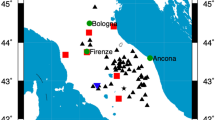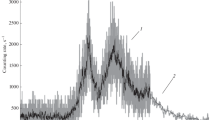Abstract
Bright bolides entering the atmosphere announce the entrance of meter-sized meteoroids often surviving as meteorites reaching the ground. To be able to find them, it is necessary to locate quickly the position of the final explosion. This is usually done using optical sensors, but the bolides produce shock waves that can be detected by infrasound stations and, after coupling to the ground, also by seismic stations. The increasing availability of temporal seismic station deployments and the gathering of the records on permanent seismic networks can become a powerful tool to complement optical data, in particular for diurnal events or explosions located far from optical stations. We present here two examples of bolides exploding over NE Iberia that were reported in the Spanish Fireball and Meteorite Network (SPMN) catalog with magnitudes − 12 and − 17 and recorded by temporary seismic arrays deployed near their entry trajectory. The location of the final explosions has been derived from the seismic data using a simplistic hypothesis and the codes used systematically for earthquake location. Although locating accurately the origin point of sonic waves is a complex task, our approach allows getting a quick location of the explosion location, with errors estimated in few kilometers that appears as a useful tool to better define the search zone for eventual meteorites.
Access provided by Autonomous University of Puebla. Download conference paper PDF
Similar content being viewed by others
Keywords
1 Introduction
In order to find possible meteorites resulting from bolide fragmentation, it becomes necessary to locate quickly the position of the explosion. This is usually done using optical sensors, which allow to identify the trajectory and final explosion of the bolide. However, as the number of such stations is limited, the distance between the explosion and the nearest optical stations might be large and the determination of the meteoroid disruption location can sometimes be not enough accurate. In addition, optical instruments cannot be used in the case of daytime meteoroids.
With the densification of the permanent seismic networks and the increasing availability of temporal seismic station deployments, seismic data can become a powerful tool to complement optical data, as the sensors detect clearly the ground coupling of acoustic waves generated by the explosion. We present here two examples of bolides exploding over NE Iberia, for which the available seismic data provides useful information.
2 Data and Methods
Obtaining a precise location of the fireball explosion using seismic waves is a complex task, as the propagation of sonic waves through the atmosphere is affected by multiple aspects, including the vertical temperature profile, the direction of the prevailing winds at each height level, humidity, and ground topography (Arrowsmith et al., 2010). We propose in this contribution the use of an oversimplified location strategy, based on the methods used routinely for earthquake location, to get a quick approximative location of the bolide explosion point. We use the classical Hypo71 (Lee & Lahr, 1975) algorithm, included as a plug-in in the SeisComP data processing package (Helmholtz-Centre Potsdam, 2008), we assume that the signal is generated during the final bolide explosion (source point) and we define an homogeneous model of the atmosphere, with a speed set at 340 m/s. It is important to note that the accuracy of this approach, as always in seismic location problems, is strongly dependent on the number and geographical distribution of the available seismic stations.
3 Results
On September 30, 2019, a fireball entered the atmosphere above NE Iberia at 08:50 UTC. Despite occurring during daylight hours, the entry of the fireball was witnessed by a significant number of observers and its fragmentation generated a burst widely noted by the population. The Spanish Fireball and Meteorite Network identified this fireball with the code SPMN300919, assigning it an absolute magnitude of − 12 ± 2. This magnitude places it among the ten fireballs of greater magnitude detected by the network during the year 2019, being the only daytime event cataloged during that year. The visual observations available indicate that the fragmentation of the bolide occurred along an east–west trajectory, over the area located between the towns of Solsona and Coll de Nargó/Oliana (NE Iberia) (yellow line in Fig. 1a).
a Map showing the temporary (dots) and permanent (triangles) seismic stations around the 30/9/2019 bolide explosion (red star). Dark blue colors show the stations with clear arrivals. Yellow line shows the trajectory inferred from witnesses. Black squares show the location of nearby towns. b Seismic traces at representative sites
This event was recorded by the permanent seismic stations located in NE Iberia (Institut Cartogràfic i Geològic de Catalunya 2000) and some stations located in the northern side of the Pyrenees. However, the most relevant contribution arises from the data acquired by the SANIMS temporary network (Diaz et al., 2023), including 25 broad-band instruments deployed over the NE termination of the Pyrenees.
The location procedure results in a source point located to the SW of the zone covered by the dense seismic network. The height of this source is calculated to be 57 km, but it is poorly constrained. As it is estimated that most fireball fragmentation do occur between 20 and 45 km (Moreno-Ibáñez et al., 2015), we consider that our data does not allow us to constraint properly the explosion height and we decide to fix this value to 35 km to obtain a more accurate location. The final results indicate that the explosion origin time was 08:48:25 and it was located at 41.988°N and 1.511°E, very close to the city of Solsona and approximately 10 km southwards from the trajectory estimated from visual witnesses, with formal errors in latitude and longitude of ± 3 km. It is worthy to note that seismic signals were recorded to distances over 80 km to the north and the east of the origin zone, but were not recorded to the south and west, probably due to the effect of the dominating winds.
On May 23, 2022, a very brightly fireball was detected over NE Iberia and reported by a large number of witnesses, in despite of occurring at 02:45 official time. The Spanish Fireball and Meteorite Network identified this fireball with the code SPMN230522, assigning it an absolute magnitude of − 17 ± 2. This is the brightest object detected by the network since January 2021 and has been observed all around central and southern Iberia. Several of the optical observatories have recorded the final explosion of the bolide, and shown the later trajectory of several fragments. From the optical measurements, it has been stated that the bolide started to bright above the coastline 15 km SW of Barcelona and followed a SSW-NNE trajectory, with the fragmentation point located 75 km further north, near the city of Vic (yellow line in Fig. 2). This event has been recorded by up to 32 seismic stations distributed over NE Iberia, including 10 stations deployed in high schools of the Barcelona metropolitan area in the framework of the SANIMS project. The classical location procedure described above has provided an origin zone located at 41.822°N and 2.911°E, with a height of 35 km. The formal errors in latitude and longitude are of ± 0.85 km, while for the height the error is estimated in ± 3.2 km. Comparing the results from the optical and seismic locations, their latitude is very similar, while there is a difference of about 15 km in longitude. In this case, the seismic signals are recorded at distances of 130 km by stations distributed all around the explosion, hence resulting in lower error bars. Station located to the SW does not record seismic arrivals associated to the explosion.
a Map showing the temporary (dots) and permanent (triangles) seismic stations around the 23/5/2022 bolide explosion (red star). Dark blue colors show the stations with clear arrivals. Yellow line shows the trajectory inferred from optical observations. Black squares show the location of the nearby towns. b Seismic traces at representative sites. c Image from the bolide taken by the all-sky camera from the Observatori Astronòmic del Montsec
4 Conclusions
Our data prove that even if using simplistic hypothesis, seismic data can be a useful tool to quickly locate the explosion point of bolides entering the atmosphere, hence allowing researchers to constrain the zone where eventual meteorites could be found. As we propose the use of a location method implemented in the data managing software packages routinely used by the seismic community, the localization of bolide explosions can be implemented as a standard procedure, as done for example with quarry blast. However, this approach relies on the availability of a large number of seismic instruments around the entry area.
Regarding the two events inspected here, for the September 30, 2019, the seismic data provided key information, as the event occurred in broad daylight without optical recordings. On contrary, the May 23, 2022, bolide was recorded by 21 optical sensors allowing to reconstruct the bolide trajectory and explosion zone, which is consistent with the seismic location, hence confirming the validity of our approach.
References
Arrowsmith, S. J., Johnson, J. B., Drob, D. P., & Hedlin, M. A. H. (2010). The seismoacoustic wavefield: A new paradigm in studying geophysical phenomena. Reviews of Geophysics, 48, 4.
Diaz, J., Ventosa, S., Schimmel, M., Ruiz, M., Macau, A., Gabàs, A., Akin, O. & Vergés, J. (2023). Mapping the basement of the Cerdanya Basin (Eastern Pyrenees) using seismic ambient noise. Solid Earth, 14, 499–514. https://doi.org/10.5194/se-14-499-2023
Helmholtz-Centre Potsdam. (2008). GFZ German Research Centre for Geosciences and gempa GmbH. The SeisComP seismological software package. GFZ Data Services
Institut Cartogràfic i Geològic de Catalunya. (2000). Catalan seismic network. International Federation of Digital Seismograph Networks. Other/Seismic Network. https://doi.org/10.7914/SN/CA
Lee, W. H. K. & Lahr, J. C. (1975). HYP071 (revised); A computer program for determining hypocenter, magnitude, and first motion pattern of local earthquakes. https://doi.org/10.3133/ofr75311
Moreno-Ibáñez, M., Gritsevich, M., & Trigo-Rodríguez, J. M. (2015). New methodology to determine the terminal height of a fireball. Icarus, 250, 544–552.
Acknowledgements
The authors want to acknowledge the Geo3Bcn-CSIC LabSis Laboratory to provide data from temporary deployments. We are grateful to all the meteor observers for sharing their observations through the citizen science project Red de Investigación sobre Bólidos y Meteoritos (SPMN-CSIC): https://www.ice.csic.es/news/citizen-science/2-uncategorised/319-spmn-network-meteorite. We thank Observatori del Montsec IEEC personnel for allsky camera maintenance. This research has been supported by the Spanish Ministerio de Ciencia, Innovación y Universidades grants numbers RTI2018-095594-B-I00 and PGC2018-097374-B-I0.
Author information
Authors and Affiliations
Corresponding author
Editor information
Editors and Affiliations
Rights and permissions
Copyright information
© 2024 The Author(s), under exclusive license to Springer Nature Switzerland AG
About this paper
Cite this paper
Díaz, J., Trigo-Rodríguez, J.M., Tapia, M., Ruiz, M. (2024). Quick Determination of Bolide Explosion Locations Using Seismic and Optic Data. In: Bezzeghoud, M., et al. Recent Research on Geotechnical Engineering, Remote Sensing, Geophysics and Earthquake Seismology. MedGU 2022. Advances in Science, Technology & Innovation. Springer, Cham. https://doi.org/10.1007/978-3-031-48715-6_62
Download citation
DOI: https://doi.org/10.1007/978-3-031-48715-6_62
Published:
Publisher Name: Springer, Cham
Print ISBN: 978-3-031-48714-9
Online ISBN: 978-3-031-48715-6
eBook Packages: Earth and Environmental ScienceEarth and Environmental Science (R0)






